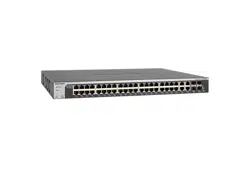Loading ...
Loading ...
Loading ...

Manage Device Security
272
ProSAFE 10-Gigabit Smart Managed Switch XS728T and XS748T User Manual
The range of the VLAN ID is 2–4093. You can enter only a VLAN that you previously
configured as a primary VLAN (see Configure the Private VLAN Type on page 266).
9. In the Promiscuous Secondary VLAN field, enter the secondary VLAN ID for promiscuous
association mode.
This field can accept single a VLAN ID, a range of VLAN IDs, or a combination of both in
sequence separated by a comma. You can specify an individual VLAN ID, such as 10.
You can specify the VLAN range values separated by a hyphen, for example, 10-13. You
can specify the combination of both separated by commas, for example,
12,15,40-43,1000-1005, 2000. The range of VLAN IDs is 2–4093.
Note: The VLAN ID list that you specify replaces the configured secondary
VLAN list in the association.
10. Click the Apply button.
The updated configuration is sent to the switch. Configuration changes take effect
immediately.
The Operational VLAN(s) field displays the operational VLANs.
Configure Access Control Lists
Access control lists (ACLs) ensure that only authorized users can access specific resources
while blocking off any unwarranted attempts to reach network resources. ACLs are used to
provide traffic flow control, restrict contents of routing updates, decide which types of traffic
are forwarded or blocked, and above all provide security for the network. The switch’s
software supports IPv4, IPv6, and MAC ACLs.
To configure an ACL:
1. Create an IPv4-based, IPv6-based, or MAC-based ACL ID.
2. Create a rule and assign it to a unique ACL ID.
3. Define the rules, which can identify protocols, source, and destination IP and MAC
addresses, and other packet-matching criteria.
4. Use the ID number to assign the ACL to a port or to a LAG.
To view ACL configuration examples, see Access Control Lists (ACLs) on page 355.
From the Security > Management Security > ACL menu, you can access the pages that
are described in the following sections:
• Use the ACL Wizard to Create a Simple ACL on page 273
• Configure a Basic MAC ACL on page 278
• Configure MAC ACL Rules on page 280
• Configure MAC Bindings on page 284
• View or Delete MAC ACL Bindings in the MAC Binding Table on page 286
Loading ...
Loading ...
Loading ...
